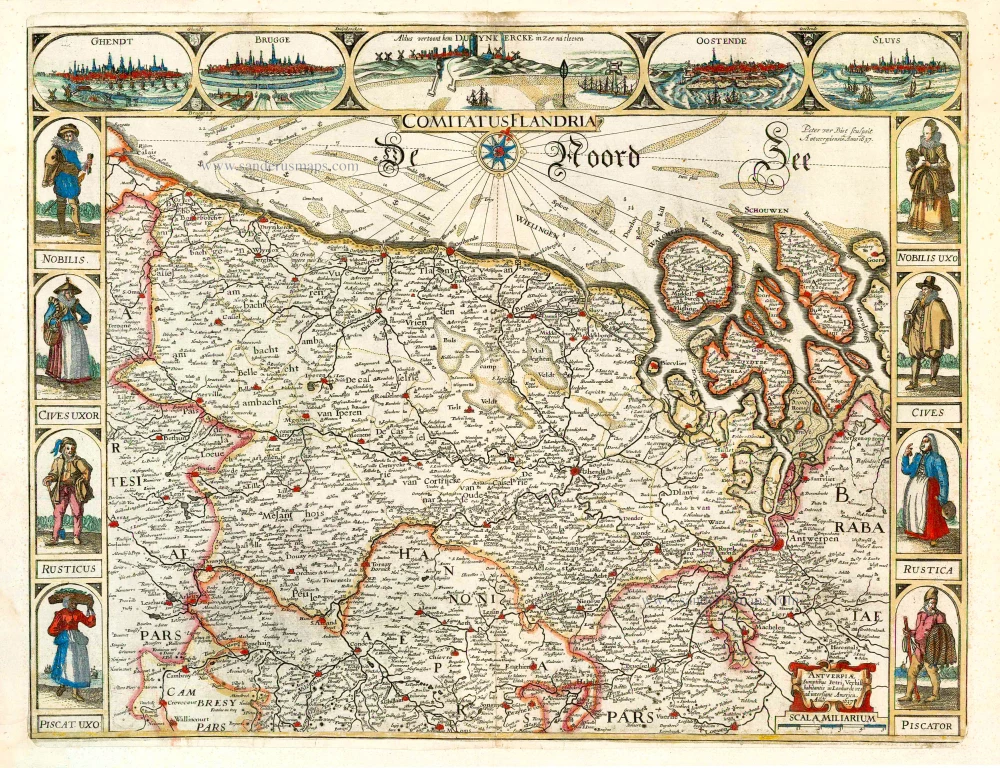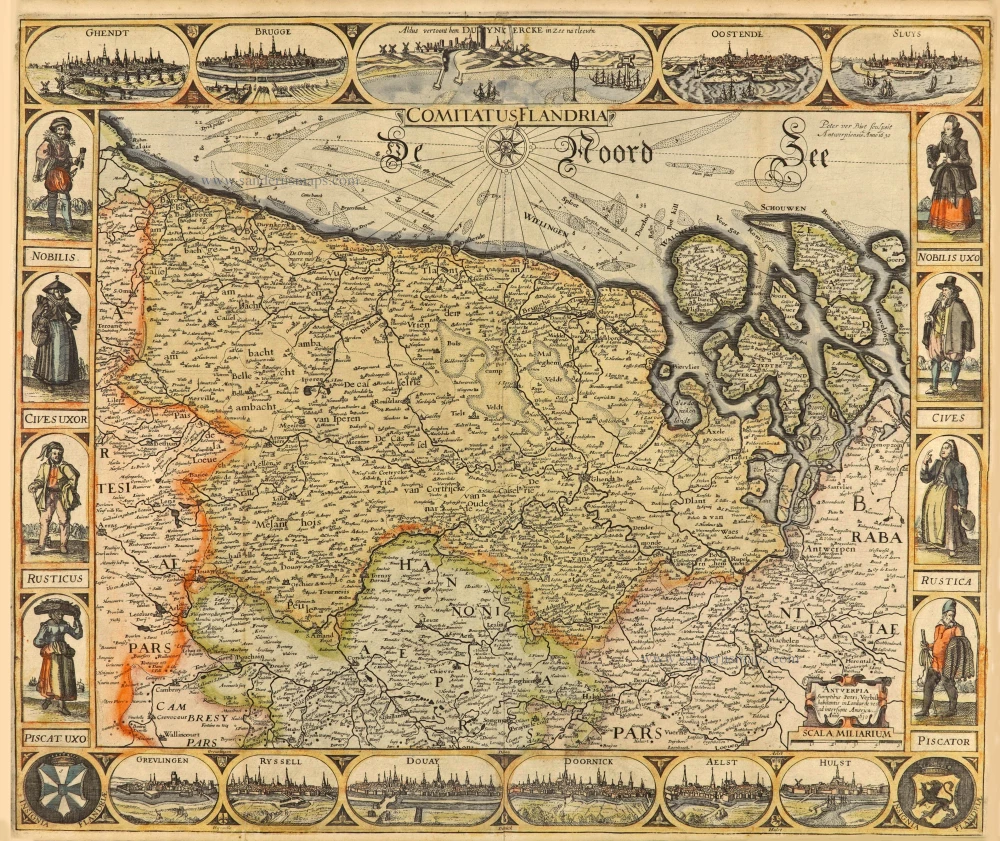Rare
Flanders (Vlaanderen), by Gerard de Jode. 1593
In 1578, Gerard de Jode published his Speculum Orbis Terrarum, an atlas aimed at competing with the Theatrum of Ortelius. However, the latter had first been issued in 1570 and had already built a commanding market presence, so despite de Jode's long-standing reputation, the atlas did not sell very well. Only a dozen or so examples have survived. Undeterred, he made plans for another expanded edition, and upon his death in 1591, it was taken on by his son Cornelis. The Speculum Orbis Terrae of 1593 did not sell well and was never reissued. Although more examples than the first edition have survived, they are scarce. Many of de Jode's maps are judged to be superior to those of Ortelius in detail and style.
Gerard and Cornelis de Jode
Gerard de Jode (Judaeus) (1508(?)-1591), a native of Nijmegen, began his career as a printer and engraver in Antwerp about 1550. He lived near the Bourse on the Catelijne Veste, or on "de Catte". He was in regular contact with Christoffel Plantin, to whom he sold many prints and maps. De Jode's business, which must have been a major one among Antwerp's many booksellers and printers, was represented at the Frankfurt fair, where de Jode bought maps that he later copied or re-sold. Most of the maps sold by De Jode have prototypes of Italian or German origin. Apart from his many separately published maps, Gerard de Jode is known for his atlas, Speculum Orbis Terrarum, published in 1578. Part of the engraving was done by himself, and part by brothers Jan and Lucas van Doetecum.
Gerard de Jode and Abraham Ortelius, who partly lived as map sellers, were competitors and only sometimes on good terms.
After the death of Gerard de Jode in 1591, the business was carried on by his widow, Pascale van Gelder and his son, Cornelis (1568-1600). More a publisher than an engraver, the latter reissued the Speculum in 1593, adding new maps and revising others.
Despite all its deficiencies, the Speculum must have had a good reputation. It is mentioned alongside Mercator's Atlas and Ortelius's Theatrum in Petrus Montanus's preface to the Germania Inferior of Pieter van den Keere.
Exactissima Flandriae Descriptio.
Item Number: 30309 Authenticity Guarantee
Category: Antique maps > Europe > Belgium
Flanders (Vlaanderen), by Gerard de Jode.
Title: Exactissima Flandriae Descriptio.
Cum privilegio.
Cartographer: M. Tramesini.
Date of the first edition: 1578.
Date of this map: 1593.
Copper engraving, printed on paper.
Image size: 357 x 485mm (14.06 x 19.09 inches).
Sheet size: 410 x 530mm (16.14 x 20.87 inches).
Verso: Blank.
Condition: Original coloured in the style of the frescoes of the Gallery of Maps in the Vatican. Recently backed with paper.
Condition Rating: A.
This is a separately issued edition without text on the back, corresponding with the second edition of de Jode's atlas Speculum Orbis Terrarum, 1593. The de Jode maps were issued with text on the back in an atlas. Separate maps were sold without text on the back; most didn't survive. Copies bound in composed atlases (atlas factice) survived more easily.
This map was contemporary coloured and mounted back to back with another map in an atlas factice. All the maps from this atlas were trimmed to the neatline and re-margined to obtain equal sizes of sheets in the atlas.
The map has recently undergone professional restoration, whereby it was removed from its contemporary backing and remounted upon a larger sheet of paper.
In 1578, Gerard de Jode published his Speculum Orbis Terrarum, an atlas aimed at competing with the Theatrum of Ortelius. However, the latter had first been issued in 1570 and had already built a commanding market presence, so despite de Jode's long-standing reputation, the atlas did not sell very well. Only a dozen or so examples have survived. Undeterred, he made plans for another expanded edition, and upon his death in 1591, it was taken on by his son Cornelis. The Speculum Orbis Terrae of 1593 did not sell well and was never reissued. Although more examples than the first edition have survived, they are scarce. Many of de Jode's maps are judged to be superior to those of Ortelius in detail and style.
Gerard and Cornelis de Jode
Gerard de Jode (Judaeus) (1508(?)-1591), a native of Nijmegen, began his career as a printer and engraver in Antwerp about 1550. He lived near the Bourse on the Catelijne Veste, or on "de Catte". He was in regular contact with Christoffel Plantin, to whom he sold many prints and maps. De Jode's business, which must have been a major one among Antwerp's many booksellers and printers, was represented at the Frankfurt fair, where de Jode bought maps that he later copied or re-sold. Most of the maps sold by De Jode have prototypes of Italian or German origin. Apart from his many separately published maps, Gerard de Jode is known for his atlas, Speculum Orbis Terrarum, published in 1578. Part of the engraving was done by himself, and part by brothers Jan and Lucas van Doetecum.
Gerard de Jode and Abraham Ortelius, who partly lived as map sellers, were competitors and only sometimes on good terms.
After the death of Gerard de Jode in 1591, the business was carried on by his widow, Pascale van Gelder and his son, Cornelis (1568-1600). More a publisher than an engraver, the latter reissued the Speculum in 1593, adding new maps and revising others.
Despite all its deficiencies, the Speculum must have had a good reputation. It is mentioned alongside Mercator's Atlas and Ortelius's Theatrum in Petrus Montanus's preface to the Germania Inferior of Pieter van den Keere.

























